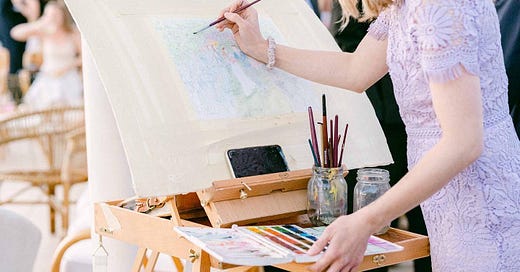There was a time when creativity felt effortless. As a kid, you probably picked up crayons without thinking. You doodled in the margins of your notebook. You made up stories, built forts, and turned sticks into magic wands. You weren’t worried about whether your art was “good”—you just made it.
But somewhere along the way, that changed.
Now, sitting down to create feels… hard. You hesitate before starting. You second-guess every brushstroke. Maybe you avoid creating altogether, convincing yourself that you’re “just not feeling inspired.”
Sound familiar? You’re not alone. And you’re definitely not broken.
Creativity Is a Muscle
Most people think creativity is a talent—something you either have or you don’t. But the truth? Creativity is more like a muscle. The more you use it, the stronger it gets. The less you use it, the weaker it becomes.
And in today’s world, we’ve unintentionally weakened it.
We consume more than we create. We overthink instead of experimenting. We expect perfection instead of play.
No wonder creativity feels hard. We’ve been treating it like a switch to flip on, when really, it’s a muscle that needs regular exercise.
Photo By Holly Felts Photography
ART TIP: Rebuilding Your Creative Strength
The good news? Just like any muscle, creativity can be rebuilt—one small habit at a time.
1. Make Bad Art on Purpose
Perfectionism is one of creativity’s biggest enemies. If you’re stuck, give yourself permission to make something bad—on purpose. Set a timer for 10 minutes and create the messiest, weirdest, most imperfect thing you can. When the pressure to be “good” is gone, you’ll be amazed at how much easier it is to create.
2. Create Every Day (Even for 5 Minutes)
You don’t need hours of free time to rebuild your creative muscle. Even five minutes a day—doodling, writing, painting—will retrain your brain to make creativity a habit instead of a struggle.
3. Limit Your Consumption
Constantly looking at other people’s work can make you feel like you’re behind before you even start. Take a break from scrolling and focus on your ideas. Creativity thrives in stillness, not comparison.
4. Play First, Judge Later
Not every piece of art has to be a masterpiece. Approach creativity with curiosity instead of judgment. Try a new technique. Use colors you never use. Play. Experiment. The goal isn’t to create something perfect—it’s to create something.
Creativity Feels Hard Because We Forgot How to Play
If making art feels harder than it used to, it’s not because you’ve lost your creativity. It’s just been buried under overthinking, perfectionism, and too much input.
The fix? Small, consistent steps. Make something—anything—every day. Let go of expectations. Treat creativity like a muscle, and watch how quickly it strengthens again.
Let’s Talk
Have you ever felt like creativity used to be easier? What small habit helps you stay creatively strong? Hit reply or drop a comment—I’d love to hear your thoughts.
Happy creating,
LOOKING FOR HELP WITH YOUR ART FOR YOUR HOME?!
I'm currently booking commissions and live events for 2025 – click here to inquire about custom commissions! Or if you'd rather find something already made, check out my latest art collections at The Scouted Studio.
PHOTO TO PAINTING MINI COMMISSION
Thanks for reading today's edition of the Stories I Only Tell My Friends newsletter! & if you're new here—hi! I'm Courtney, fine artist and live wedding painter, honored to paint beautiful celebrations around the 🌎. I'd love for you to stick around and subscribe to keep reading one art tip, once a week. :)






